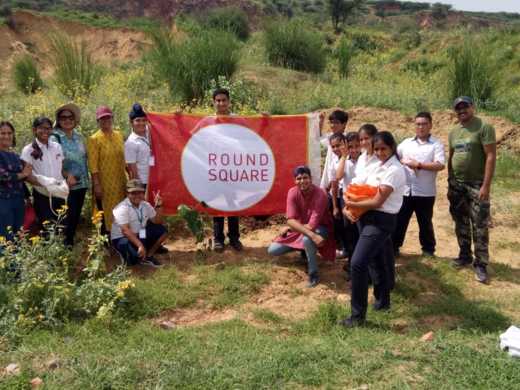The Shri Ram School Aravali’s Seed Bomb’s
Posted: 07 October 2019

IDEALS
- Environmentalism
Discovery
- Problem solving
- Sense of responsibility
- Commitment to sustainability
- Tenacity
- Teamwork
- Inventiveness
- Compassion
Overview
The Environment Society at The Shri Ram school Aravali have been undertaking a project to give nature a helping hand by making and launching ‘seed bombs’. A seed bomb is a marble sized ball made of clay, earth and seeds which is used to replant areas where the natural flora has been destroyed. Once the bomb has been thrown and the seeds have begun to germinate the bomb will slowly break apart. The soil will then provide a base for the seeds to start growing.
Students divided themselves in groups and walked down a stretch of land in Sakatpur, Gurgaon throwing the seed bombs in areas easily accessible to rainwater. Students also scattered the seeds of the Amaltas plant which is known for its medicinal properties and planted a peepal tree with the hope that this new flora will help increase wildlife habitat enhance natural beauty.
Planning
This activity was driven by the Environment society students. They had got an external person to train them to make seed bombs. They then identified the space and then the students went and dispersed the seeds.
Activity
Seed Ball Recipe
- 2 parts potting soil;
- 5 parts pottery clay mix from your local art store;
- 1-2 parts water;
- 1-2 parts indigenous seeds (our seeds were picked up from the ground in school like the neem seed. Some the students bought from home);
- Large tub to mix ingredients; and
- Large box to dry and store seed balls.
Directions:
- Mix the soil, clay and 1 part water thoroughly. There should be no lumps. Slowly add more water until the mixture is the consistency of the toy store moulding clay that comes in a can.
- Add seeds. Keep kneading the dough until the seeds are well mixed in. Add more water if necessary.
- Take small bits of the clay mixture and roll into ball about one inch in diameter. The balls should hold together easily. If they’re crumbly, add more water.
- Dry seed balls for 24-48 hours in a shady place before sowing or storing. They store best in a cardboard box. Do not use plastic bags.
- The last step in how to make flower seed balls is sowing them. Yes, you can place them carefully over the area to be planted or you can gently toss them one at a time, which is a lot more fun. Don’t bury them and don’t water them. You’ve done your job, now sit back and leave the rest to Mother Nature.
Challenges
To be fair, seed bombing is not easy. It takes perseverance and trial-and-error to get things right an to ensure that your little seed bombs actually germinate and eventually root and go on to be full grown trees!
The main challenge is ensuring the ground and location is suitable for seed bombs. Rainfall is a vital factor as the seeds will require water to grow. We did this activity around monsoon season. You need to also ensure that you only use indigenous plants to the area to ensure you do not disrupt the established eco-system and to increase the likely-hood of the plants taking hold.
Impact
Not only was this activity a hugely enjoyable one for our students, but they develop a better understanding of their local environment. Students were able to reconnect with nature, increase their appreciation for their surroundings, deepen their sense of connection with nature, inspire a spirit of environmental stewardship.
Long term outcomes
Restoring native plant habitat is vital to preserving biodiversity. By re-introducing native plans, each patch of habitat becomes part of a collective effort to nurture and sustain the living landscape for birds and other animals. Once established, native plants generally require little maintenance.
Native plants’ growth habits keep soil in place, store water where it’s most needed, and stop storm water from running off into waterways. Their dense forms, lush foliage, and plentiful flowers break the fall of plummeting raindrops, causing rainwater to drip into (rather than flood) the soil; the plants’ extensive, deep root systems siphon off moisture and prevent soil from eroding. Which is perfect for India who experiences annual Monsoons.
Following the success of this year we plan to do this activity every year during the monsoon.
Advice
To increase the likely hood of your seed bombs being effective you may want to consider the following:
- research the best areas to cover with your seed bombs – the ground must be suitable otherwise the seeds will not take;
- Timing matters, research the best time of year to distribute your seeds to ensure they have the right temperature and weather needed to grow;
- Use ‘fresh’ seeds. To germinate, seed must be viable, meaning it must be alive/respiring.
- Moisture matters. As a rule, most seeds’ germination and growth depends on access to water, so consider this when selecting your location.
